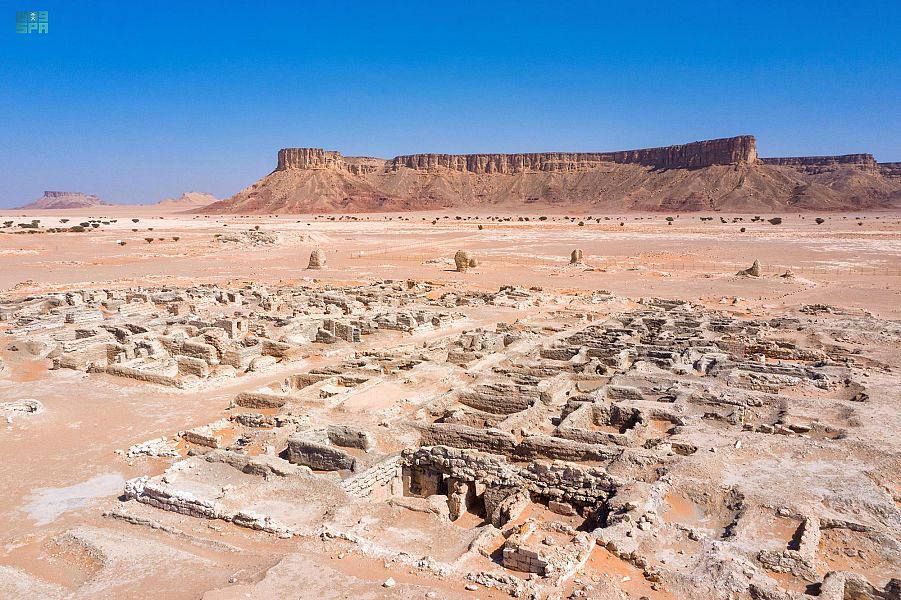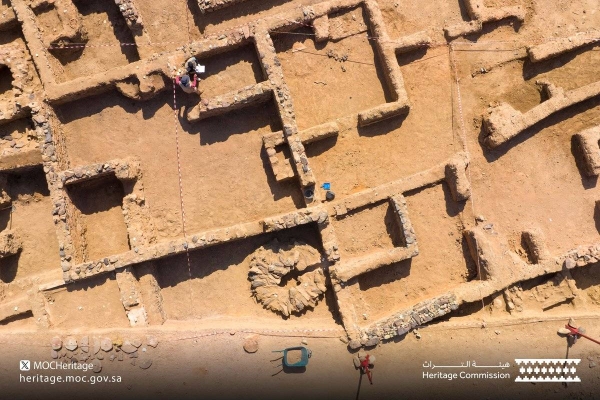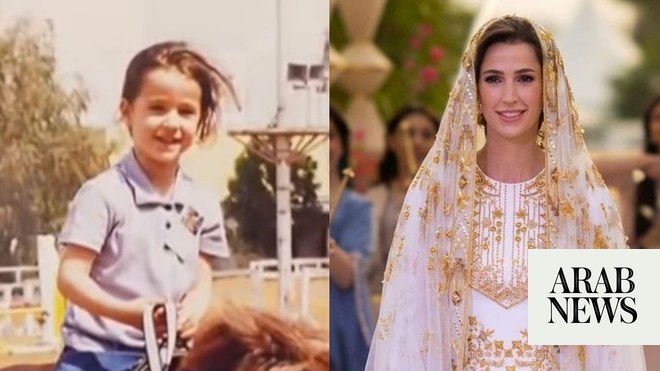
Riyadh, July 26, 2022, SPA -- The Saudi Heritage Commission today unveiled the discoveries made by a Saudi-international scientific team at the site of Al-Faw. Once the capital of the Kingdom of Kindah, Al-Faw is located on the edge of Al-Rub’ Al-Khali (the Empty Quarter), 100km south of Wadi Al-Dawasir on the modern route connecting the cities of Wadi Al-Dawasir and Najran.
In a project spearheaded by the Heritage Commission, a Saudi-led multinational team of archaeologists conducted a comprehensive survey of the site using state-of-the-art technology. The study leveraged high-quality aerial photography; guided drone footage utilizing ground control points; a topographic survey; remote sensing, ground-penetrating radar; laser scanning; and geophysical survey, as well as extensive walkover surveys and sondages throughout the site.
The survey has yielded several discoveries, the most significant of which are the remains of a stone temple and parts of an altar, where the locals of Al-Faw would have practiced their rituals and ceremonies. The rock-cut temple sits on the edge of Mount Tuwaiq, known as Khashem Qaryah, east of Al-Faw.
Moreover, remains of 8,000-year-old Neolithic human settlements have been discovered along with 2,807 graves of different periods dotted throughout the site, which have been documented and classified into six groups.
Several devotional inscriptions were found throughout the grounds, enriching our understanding of the religious belief system of the community that inhabited the site. Among these is the inscription in the Jabal Lahaq sanctuary addressed to the god Kahal, the deity of Al-Faw, by a person named W H B L T (Wahb Allat) from the family of M L H T (Malha), locals of Guerra (the city of Al-Jarha). The significance of the inscription lies in its attribution to a family from the city of Al-Jarha and referring to the ancient name of the place where the sanctuary was built (Mount Tuwaiq).
The inscription indicates a relationship between the cities of Al-Faw and Al-Jarh? – most likely commercial considering Al-Faw's location on the ancient trade route. It may also imply either religious tolerance between residents of the two cities, or the worship of Al-Faw's deity, Kahal, by some of the residents of Al-Jarha. Though Al-Jarha was known for its wealth and economic power, its location has not yet been definitively identified, and several scholars associate it with the site of Thaj.
The discovery offers valuable data regarding the geographical distribution of Al-Faw's sanctuaries, as well as revealing the foundations of four monumental buildings, some with corner towers. Their architecture, internal plans, and open-air courtyards suggest their use as resting places for trade caravans.
The archaeological study further uncovered a complex irrigation system, including canals, water cisterns, and hundreds of pits, dug by the residents of Al-Faw to bring rainwater to the agricultural areas. This may explain how the inhabitants of these lands overcame and adapted to the arid climate and minimal rainfall of one of the world’s harshest desert environments. Extensive surveys and remote-sensing images have revealed several agricultural fields used to grow various crops to sustain residents.
Discoveries include a series of rock art and inscriptions carved on the face of Mount Tuwaiq, narrating the story of a man named Madhekar bin Muneim, and illustrating daily scenes of hunting, travel, and battle.
Fieldwork at Al-Faw had first been initiated by King Saud University in the 1970s in a study supervised by Prof. Abdulrahman Al-Ansari, lasting for over 40 years. The study uncovered many cultural aspects of the site, notably the residential and market areas, temples, and tombs. The results of these archaeological activities were later published in seven book volumes.
The new findings are a result of the Heritage Commission’s ongoing efforts to study, protect and preserve the nation’s cultural heritage sites. Research at the site will continue to build a greater understanding of the cultural landscape of Al-Faw archaeological area.
--SPA
16:02 LOCAL TIME 13:02 GMT
0015
www.spa.gov.sa/w1766395










